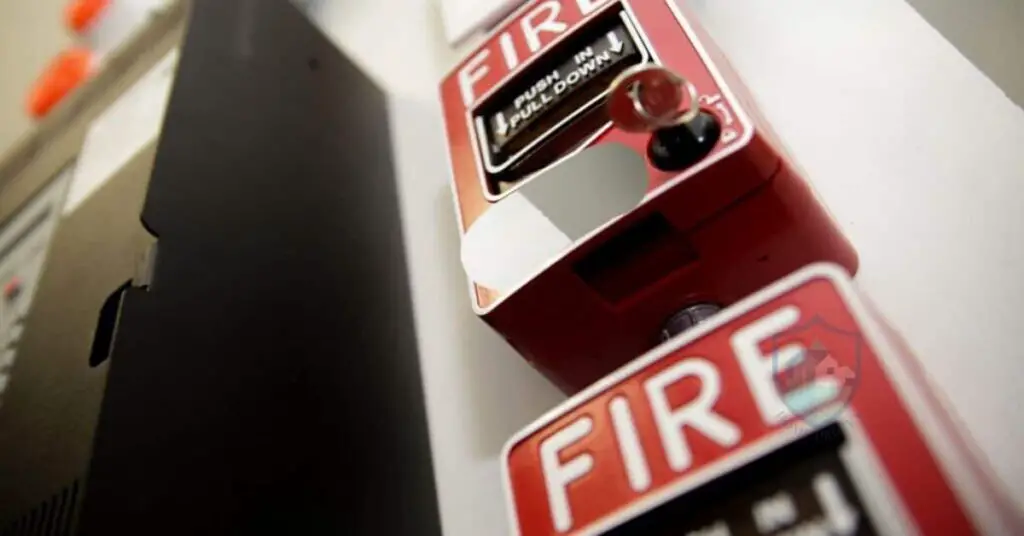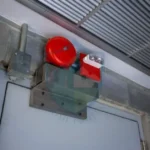Table of Contents
Do you want to know what SLC and NAC in fire alarm systems mean? Yes, SLC is used to receive signals from initiating devices, while the NAC is used to provide signals to notification devices.
The piercing sound of the fire alarm startles you awake. It’s 2am. Confused and still half-asleep, you make your way out of the building along with other residents. Thankfully, it was just a drill.
But it made me think – what if it was real? How does that ear-splitting horn actually work to wake us up and get us to safety? I realized I took for granted the technology that could one day save my life.
I became obsessed with learning what makes fire alarms tick. More specifically, what are those mysterious abbreviations I keep hearing – SLC and NAC? I asked some engineer friends but they strategically avoided giving me a simple answer.
That’s when I decided to take matters into my own hands. I dove headfirst into the technical intricacies of fire protection systems. Believe me, it wasn’t easy making sense of those complicated codes and circuit diagrams!
But now I can proudly say I’ve finally demystified what SLC and NAC mean and how they enable an integrated fire alarm system. It’s fascinating stuff, even if you’re not an electrical engineer.
In this guide, I’ll explain in simple terms how SLC and NAC work together to detect smoke, sound alarms, flash notification lights, and much more.
My goal is to break down these complex concepts so that anyone can understand the technology that keeps us safe.
Here we comes.
A Comprehensive Guide to SLC and NAC in Fire Alarm Systems
What Is SLC In Fire Alarm System
SLC stands for Signaling Line Circuit. It’s the central nervous system that runs your fire alarm operation.
Without SLC, your fire alarm panels and devices are about as useful as a smartphone without a processor. SLC gives your system intelligence to make timely and life-saving decisions.
What Exactly Does SLC Do?
The SLC circuit connects your fire alarm control panel (FACP) to all the devices that detect problems and trigger alarms.
This includes:
- Smoke detectors
- Heat detectors
- Pull stations
- Input modules
- Output modules
SLC carries information back and forth between all these devices and the main panel.
For example, when a smoke detector senses smoke particles, it sends a signal over the SLC circuit to the FACP.
The FACP processes this data and determines the appropriate response – like activating notification appliances to evacuate occupants.
From Dumb to Smart – Enter Addressable SLC
Early fire alarm systems used simple parallel wiring for detectors. All devices were wired in one big circuit.
So when one detector sensed a problem, the panel only knew that something in that circuit was wrong. But it couldn’t pinpoint exactly which detector.
This is called a conventional or non-addressable system.
Addressable SLC was a game changer. It allowed each device to have a unique identifier on the circuit.
This let the FACP know precisely which detector or module was in alarm or trouble. And it could take immediate, targeted action.
Addressable systems became mandatory in many commercial buildings. They reduced false alarms and sped up incident response.
How to Design and Wire an SLC Circuit
SLC circuits are wired in a loop from the FACP, through all devices, and back to the panel. This closed loop offers enhanced reliability.
Typically, shielded twisted-pair 18 – 22 AWG fire rated cable is used. Belden FPLP is a common SLC cable choice.
Class A SLC circuits provide redundancy with dual paths. If the line is cut or damaged, the return path keeps communication active.
Class B circuits are single path so a fault can disrupt the SLC. But Class B is often acceptable for smaller systems.
Each device is given a unique address – say 105 for a smoke detector in room 105. The FACP tracks each device’s status and location.
Most panels support up to 250 devices on a single SLC circuit. Larger systems use multiple SLCs.
Voltages range from 10-30VDC depending on the devices. 24V is most common. Noise filters help reduce interference.
Keeping a Watchful Eye on SLC
Modern panels continuously monitor the SLC circuit. Any issues with wiring, cable damage or a device fault will be reported.
This allows for preventative maintenance. Problems can be fixed before devices stop communicating.
Each device reports diagnostic data like dust contamination or sensor drift. The FACP logs it all for troubleshooting.
If too many devices are out of service, the panel can indicate a degraded system requiring urgent repairs.
SLC Circuit = Smart Nervous System
Hopefully you now see why SLC is the real brains behind a fire alarm system.
It gives everything you wire to it – whether a detector, horn, light, or other module – the ability to intelligently communicate status and alerts.
This allows immediate and precise incident response that would never be possible in old-fashioned conventional hardwired systems.
So if someone mentions SLC circuits for your building’s fire system, you can confidently nod along like you’re in the know. You’ve just mastered the basics of this critically important fire protection technology!
Sirens, Strobes, and Speakers – Demystifying NAC Circuits
You’ve now got a solid grasp of the brains behind a fire alarm system – SLC signaling line circuits. Now let’s dive into NAC – notification appliance circuits.
What Is NAC In Fire Alarm System
If SLC is the brains, NAC is the mouth – it’s responsible for the sights and sounds that warn occupants of an emergency.
What Does a NAC Circuit Do?
NAC circuits power all the audible and visible notification appliances in a fire alarm system. These include:
- Horns
- Speakers
- Strobes
- Combination horn/strobes
When the fire alarm panel detects a smoke or fire incident via SLC, it commands the NAC circuits to activate the correct notification devices.
This will:
- Alert occupants to evacuate using sirens and voice messages
- Guide occupants to exits with flashing visibility
- Notify first responders
Conventional vs Addressable NAC
Like SLC, NAC circuits can either be conventional or addressable.
A conventional NAC circuit connects all devices in a simple parallel wiring fashion.
The FACP can only command the entire NAC circuit – not individual devices. It’s all or nothing.
Addressable NAC allows the fire panel to communicate with each appliance independently.
This means only strobes in affected zones need to be activated. Or specific pre-recorded messages can be played over speakers.
Addressable NAC provides more flexibility. But conventional NAC may be suitable for smaller, less complex systems.
Designing and Wiring NAC Circuits
NAC circuits should be designed with survivability and redundancy in mind to ensure continuous operation when needed most.
Common practices include:
- Class A or Class B wiring
- Survivability rated FPLP or similar fire-rated cable
- Adequate wire gauge for voltage drops
- Maximum 25-30VDC and amperage limits
- Separate circuits for audible and visible devices
The circuit architecture can be radial, distributed branch, or a hybrid.
All wiring must be installed per NEC, NFPA, and local codes. Terminations and splices require special care.
Achieving Sufficient Coverage
The goal is to achieve:
- Audibility of 15dB above ambient noise
- Visible strobes throughout corridors and rooms
- Intelligible voice messages
This requires thoughtful device placement and wiring design. Too few appliances or excessive distances can compromise coverage.
Testing and adjustments during commissioning ensure requirements are met. Updates may be needed if room usage changes.
Syncing Sights and Sounds
NFPA 72 contains stringent syncing requirements for NAC devices.
All strobes must flash in unison. Speakers play the same message. And temporal horn patterns must be synchronized.
This is easily achievable with proper NAC circuit design. But problems can occur on complex systems if not tested thoroughly.
Get Your NAC Circuits in Order
Hopefully this demystifies the magic behind those ringing horns and flashing lights when a fire incident occurs.
NAC circuits power these life-saving notification appliances that alert and guide building occupants.
With both SLC and NAC mastered, you’re on your way to becoming a fire system pro! Let’s reinforce the knowledge with some examples of these circuits in action.
From Theory to Practice – Designing and Installing SLC and NAC
Now that we’ve covered the purpose and fundamentals of SLC and NAC circuits, let’s get practical.
How do you take those concepts and design a properly functioning system?
In this section I’ll share tips, best practices, and code requirements for planning, installing, and testing these critical fire alarm circuits.
Design Factors for Layout and Wiring
When laying out SLC and NAC circuits, key factors include:
Wire length limits – the total wiring distance for each circuit should not exceed NFPA and manufacturer specifications. Excessive length can cause voltage drops.
Number of devices per circuit -sizing the circuits based on device quantities to avoid overloading a single SLC or NAC.
Interference – avoiding sources of electrical noise like motors, generators, or transformers which can disrupt signaling.
Separation and survivability – wiring redundancy via Class A circuits and physical separation of equipment.
Future expansion – leaving spare capacity for additional devices.
Wire and Cable Selection
Choosing the proper wire and cable type for SLC and NAC circuits is critical.
Some options include:
FPLP – fire alarm power limited plenum cable. UL listed for fire systems.
FPLR – FPLP, but rated for riser applications.
IMSA – instrumentation, control cable for SLC data transmission.
Key metrics like gauge, voltage rating, and plenum vs. riser rating must align with the circuit requirements and environment.
Installation Process and Testing
Meticulous installation practices are vital for system reliability. Some tips:
- Follow manufacturer wiring guidelines
- Use compatible terminals and splices
- Avoid kinks, tight bends, and cable damage
- Verify all connections are secure
- Label all circuits, devices, and terminals
Once installed, comprehensive testing and inspection ensures proper functionality:
- Validate cable wiring with continuity tests
- Check each device address and configuration
- Perform acceptance testing per NFPA 72
- Diagnostic walkthroughs to confirm operation
- Correct any issues prior to final commissioning
Documentation is Key
Thorough documentation is required by NFPA 72 throughout the planning, installation, and testing process. This includes:
- Circuit diagrams
- Wiring details
- Device addresses
- Inspector and testing reports
- Records of any changes or modifications
This documentation becomes critical for inspectors, future service techs, and anyone needing to understand or modify the system.
Ready for Installation?
This overview highlights the attention to detail required when taking fire alarm circuit designs from paper to the real world.
Careful planning matched with quality installation and testing practices are essential for building a robust, reliable system.
With diligence and the right know-how, you’ll be ready to tackle an SLC and NAC implementation for your next project.
Difference Between NAC and SLC
Here is the difference between NAC and SLC:
| Characteristic | NAC (Notification Appliance Circuit) | SLC (Signaling Line Circuit) |
|---|---|---|
| Purpose | Responsible for powering and activating audible and visual notification devices (e.g. horns, speakers, strobes) during a fire alarm event. | The central communication circuit that connects the fire alarm control panel to all the initiating devices (e.g. smoke detectors, heat detectors, pull stations) to monitor for alarm conditions. |
| Operation | When the fire alarm panel detects an alarm, it commands the NAC circuits to activate the appropriate notification appliances. | The SLC carries signals back and forth between the fire alarm panel and the initiating devices, allowing the panel to determine the exact source and location of the alarm. |
| Wiring Topology | Can be conventional (all devices wired in parallel) or addressable (each device has a unique identifier). | Typically wired in a closed loop configuration, with addressable devices on the circuit. |
| Flexibility | Addressable NAC allows the panel to selectively activate only the necessary notification appliances. Conventional NAC activates all devices together. | Addressable SLC allows the panel to pinpoint the exact initiating device in alarm, enabling faster and more targeted response. |
| Reliability | Requires redundant wiring (Class A) for survivability. | Also benefits from redundant Class A wiring for enhanced reliability. |
In Closing
We’ve covered the key fire alarm circuits – SLC and NAC. The signaling brain, and the sounding voice.
Remember the difference between conventional vs addressable, and Class A wiring. Follow NFPA code. Mind the details in design.
Now it’s time to take action. Arm yourself with NFPA 72. Seek NICET training. Ask vendors questions. Stay diligent, stay safe.
The alarm is sounding – will you hear it? Heed it? Act on it? Prepare today and save lives tomorrow.




